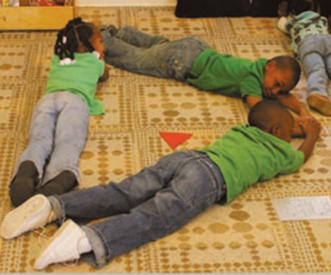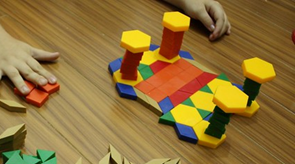5.3: Shapes and Spatial Relations
- Page ID
- 205707
\( \newcommand{\vecs}[1]{\overset { \scriptstyle \rightharpoonup} {\mathbf{#1}} } \)
\( \newcommand{\vecd}[1]{\overset{-\!-\!\rightharpoonup}{\vphantom{a}\smash {#1}}} \)
\( \newcommand{\id}{\mathrm{id}}\) \( \newcommand{\Span}{\mathrm{span}}\)
( \newcommand{\kernel}{\mathrm{null}\,}\) \( \newcommand{\range}{\mathrm{range}\,}\)
\( \newcommand{\RealPart}{\mathrm{Re}}\) \( \newcommand{\ImaginaryPart}{\mathrm{Im}}\)
\( \newcommand{\Argument}{\mathrm{Arg}}\) \( \newcommand{\norm}[1]{\| #1 \|}\)
\( \newcommand{\inner}[2]{\langle #1, #2 \rangle}\)
\( \newcommand{\Span}{\mathrm{span}}\)
\( \newcommand{\id}{\mathrm{id}}\)
\( \newcommand{\Span}{\mathrm{span}}\)
\( \newcommand{\kernel}{\mathrm{null}\,}\)
\( \newcommand{\range}{\mathrm{range}\,}\)
\( \newcommand{\RealPart}{\mathrm{Re}}\)
\( \newcommand{\ImaginaryPart}{\mathrm{Im}}\)
\( \newcommand{\Argument}{\mathrm{Arg}}\)
\( \newcommand{\norm}[1]{\| #1 \|}\)
\( \newcommand{\inner}[2]{\langle #1, #2 \rangle}\)
\( \newcommand{\Span}{\mathrm{span}}\) \( \newcommand{\AA}{\unicode[.8,0]{x212B}}\)
\( \newcommand{\vectorA}[1]{\vec{#1}} % arrow\)
\( \newcommand{\vectorAt}[1]{\vec{\text{#1}}} % arrow\)
\( \newcommand{\vectorB}[1]{\overset { \scriptstyle \rightharpoonup} {\mathbf{#1}} } \)
\( \newcommand{\vectorC}[1]{\textbf{#1}} \)
\( \newcommand{\vectorD}[1]{\overrightarrow{#1}} \)
\( \newcommand{\vectorDt}[1]{\overrightarrow{\text{#1}}} \)
\( \newcommand{\vectE}[1]{\overset{-\!-\!\rightharpoonup}{\vphantom{a}\smash{\mathbf {#1}}}} \)
\( \newcommand{\vecs}[1]{\overset { \scriptstyle \rightharpoonup} {\mathbf{#1}} } \)
\( \newcommand{\vecd}[1]{\overset{-\!-\!\rightharpoonup}{\vphantom{a}\smash {#1}}} \)
\(\newcommand{\avec}{\mathbf a}\) \(\newcommand{\bvec}{\mathbf b}\) \(\newcommand{\cvec}{\mathbf c}\) \(\newcommand{\dvec}{\mathbf d}\) \(\newcommand{\dtil}{\widetilde{\mathbf d}}\) \(\newcommand{\evec}{\mathbf e}\) \(\newcommand{\fvec}{\mathbf f}\) \(\newcommand{\nvec}{\mathbf n}\) \(\newcommand{\pvec}{\mathbf p}\) \(\newcommand{\qvec}{\mathbf q}\) \(\newcommand{\svec}{\mathbf s}\) \(\newcommand{\tvec}{\mathbf t}\) \(\newcommand{\uvec}{\mathbf u}\) \(\newcommand{\vvec}{\mathbf v}\) \(\newcommand{\wvec}{\mathbf w}\) \(\newcommand{\xvec}{\mathbf x}\) \(\newcommand{\yvec}{\mathbf y}\) \(\newcommand{\zvec}{\mathbf z}\) \(\newcommand{\rvec}{\mathbf r}\) \(\newcommand{\mvec}{\mathbf m}\) \(\newcommand{\zerovec}{\mathbf 0}\) \(\newcommand{\onevec}{\mathbf 1}\) \(\newcommand{\real}{\mathbb R}\) \(\newcommand{\twovec}[2]{\left[\begin{array}{r}#1 \\ #2 \end{array}\right]}\) \(\newcommand{\ctwovec}[2]{\left[\begin{array}{c}#1 \\ #2 \end{array}\right]}\) \(\newcommand{\threevec}[3]{\left[\begin{array}{r}#1 \\ #2 \\ #3 \end{array}\right]}\) \(\newcommand{\cthreevec}[3]{\left[\begin{array}{c}#1 \\ #2 \\ #3 \end{array}\right]}\) \(\newcommand{\fourvec}[4]{\left[\begin{array}{r}#1 \\ #2 \\ #3 \\ #4 \end{array}\right]}\) \(\newcommand{\cfourvec}[4]{\left[\begin{array}{c}#1 \\ #2 \\ #3 \\ #4 \end{array}\right]}\) \(\newcommand{\fivevec}[5]{\left[\begin{array}{r}#1 \\ #2 \\ #3 \\ #4 \\ #5 \\ \end{array}\right]}\) \(\newcommand{\cfivevec}[5]{\left[\begin{array}{c}#1 \\ #2 \\ #3 \\ #4 \\ #5 \\ \end{array}\right]}\) \(\newcommand{\mattwo}[4]{\left[\begin{array}{rr}#1 \amp #2 \\ #3 \amp #4 \\ \end{array}\right]}\) \(\newcommand{\laspan}[1]{\text{Span}\{#1\}}\) \(\newcommand{\bcal}{\cal B}\) \(\newcommand{\ccal}{\cal C}\) \(\newcommand{\scal}{\cal S}\) \(\newcommand{\wcal}{\cal W}\) \(\newcommand{\ecal}{\cal E}\) \(\newcommand{\coords}[2]{\left\{#1\right\}_{#2}}\) \(\newcommand{\gray}[1]{\color{gray}{#1}}\) \(\newcommand{\lgray}[1]{\color{lightgray}{#1}}\) \(\newcommand{\rank}{\operatorname{rank}}\) \(\newcommand{\row}{\text{Row}}\) \(\newcommand{\col}{\text{Col}}\) \(\renewcommand{\row}{\text{Row}}\) \(\newcommand{\nul}{\text{Nul}}\) \(\newcommand{\var}{\text{Var}}\) \(\newcommand{\corr}{\text{corr}}\) \(\newcommand{\len}[1]{\left|#1\right|}\) \(\newcommand{\bbar}{\overline{\bvec}}\) \(\newcommand{\bhat}{\widehat{\bvec}}\) \(\newcommand{\bperp}{\bvec^\perp}\) \(\newcommand{\xhat}{\widehat{\xvec}}\) \(\newcommand{\vhat}{\widehat{\vvec}}\) \(\newcommand{\uhat}{\widehat{\uvec}}\) \(\newcommand{\what}{\widehat{\wvec}}\) \(\newcommand{\Sighat}{\widehat{\Sigma}}\) \(\newcommand{\lt}{<}\) \(\newcommand{\gt}{>}\) \(\newcommand{\amp}{&}\) \(\definecolor{fillinmathshade}{gray}{0.9}\)Course Competency 5. Examine strategies that teach early math skills.
5.3. describe shapes and spatial relationships.
Supporting Geometry
 https://dpi.wi.gov/sites/default/files/imce/fscp/pdf/ec-wmels-rev2013.pdf
https://dpi.wi.gov/sites/default/files/imce/fscp/pdf/ec-wmels-rev2013.pdf
Please see the Wisconsin Model Early Learning Standards for Mathematical Thinking to review the standards, developmental continuum and sample behaviors of adults.
The information below is from the California Preschool Standards and is again provided as a reference to the age you may see these geometry related skills appear. However, remember the Wisconsin Model Early Learning Standards include the skills for Shapes and spatial relationships in order of development but do not assign a specific age to any skills as all children develop at their own rate and time.
Examples in 1.0 and 2.0 would correlate to WMELS B.EL. 3 Explores, recognizes, and describes shapes and spatial relationships

Geometry is a branch of mathematics that studies the sizes, shapes, positions, and dimensions of things. “Geometric and spatial thinking are important in and of themselves, because they connect mathematics and the physical world… and because they support the development of number and arithmetic concepts and skills” (Progressions for the Common Core State Standards in Mathematics, 2013). The Progressions document goes on to say,
“learning geometry cannot progress in the same way as learning number, where the size of the numbers is gradually increased and new kinds of numbers are considered later. In learning about shapes, it is important to vary the examples in many ways so that students do not learn limited concepts that they must later unlearn. From Kindergarten on, students experience all of the properties of shapes that they will study in Grades K–7, recognizing and working with these properties in increasingly sophisticated ways. The Standards describe particular aspects on which students at that grade level work systematically, deeply, and extensively, building on related experiences in previous years” (Progressions for the Common Core State Standards in Mathematics, 2013).
Former NCTM President J. Michael Shaughnessy said, “If algebra is the language of mathematics, geometry is the glue that connects it” (Shaughnessy, 2011). Additionally, geometry “covers the skills and concepts of visualization, spatial reasoning and representation, and analyzing characteristics and properties of two- and three-dimensional shapes and their relationships” (Lappan, 1999). In the Kansas Mathematics Standards, geometry spans every grade level from kindergarten to grade eight; it first begins with spatial sense, an intuition about shapes and the relationships between them including an ability to recognize, visualize, represent, and transform geometric shapes.
Van Hiele Levels for Teaching Geometry
The development of geometric thinking comes from Pierre van Hiele and Dina van Hiele-Geldof. The van Hieles identified five levels of geometric thinking through which students pass. Most elementary students are at levels 0 or 1 and some middle school students are at level 2. The levels are developmental – children of any age begin at level 0 and progress to the next level through experiences with geometric ideas (Van de Walle, Karp, Bay-Williams, 2019).
Level 0: Visualization
Students begin by recognizing shapes by their whole appearance, but not exact properties. For example, students see a door as a rectangle or a clown’s hat as a triangle, but may not be able to recognize the shape if it is rotated. The emphasis at Level 0 is on shapes that students can observe, feel, build/compose, or take apart/decompose. The goal of Level 0 is to explore how shapes are alike and how they are different and use these ideas to create classes of shapes (Van de Walle, Karp, Bay-Williams, 2019).
Level 1: Analysis
At this level, students start to learn and identify parts of figures and can describe a shape’s properties. Additionally, students at this level understand that shapes in one group have the same properties. For example, students know that parallelograms have opposite sides that are parallel and can talk about the properties of all parallelograms, not just this one. Students at Level 1 use physical models and drawing of shapes and use the properties of shapes such as symmetry, classification, and congruent sides and angles.
Level 2: Informal Deduction/Abstraction
Students at Level 2 start to recognize the relationship between properties of shapes and develop relationships between these properties. Students will consider if-then reasoning, such as “If all four angles are right angles, the shape must be a rectangle. If it is a square, all angles are right angles. If it is a square, then it must be a rectangle.” Level 2 includes informal logical reasoning and should be encouraged to ask “Why?” or “What if?” Additionally, Level 2 tasks emphasize logical reasoning.
Level 3: Formal Deduction
At this level, students analyze informal arguments and are capable of more complex geometric concepts. A student at this level is usually in high school.
Level 4: Rigor
The last level of geometric reasoning is the ability to compare geometric results in different axiomatic systems; they see geometry in the abstract. A student at this level is usually a college mathematics major.
Read this short article from NRICH for some activities required at each of the levels of geometric thinking.
In order to support students as they move from a Level 0 to a Level 1, teachers should focus on the following:
- Focus on the properties of shapes rather than the identification of those shapes,
- Challenge students to test their ideas about shapes using a variety of examples, and
- Provide multiple opportunities for students to draw, build, make, compose, and decompose shapes.

Shapes and their Properties
Students should first focus on the location and position of shapes in order to develop a variety of skills that will contribute to their spatial thinking. In kindergarten, students are expected to describe the position of shapes in the environment using the terms above, below, beside, in front of, behind, and next to. Additionally, students develop spatial sense by connecting geometric shapes to their everyday lives and shapes in their environment.
Students must have experience with a variety of two- and three-dimensional shapes. Additionally, triangles should be shown in several forms and not always with the vertex at the top or the base horizontal with the bottom of the paper (Van de Walle, Karp, & Bay-Williams, 2019).
Kindergarten students learn to describe shapes by their attributes and should be given multiple opportunities to build physical models. When students build and manipulate shapes, they can learn to explore and describe the number of sides and corners (vertices). Ask students to describe shapes by the properties, such as “squares have four sides of equal length.”
Two-dimensional shapes
It is in kindergarten that students learn to distinguish between two- and three-dimensional shapes. Two-dimensional shapes are flat and can be measured in only two ways such as length and width. Examples of two-dimensional shapes are squares, circles, triangles, etc.
Classifying shapes begins in kindergarten. And when students sort and classify polygons, they should determine the groupings, not the teacher. In second grade, students focus on triangles, quadrilaterals, pentagons, and hexagons. Third grade students think about the subcategories of quadrilaterals, and by fifth grade, they “understand the attributes belonging to a category of two-dimensional figures also belong to all subcategories of that category.” For example, a square is a rectangle and a square is also a rhombus.
Composing and Decomposing
Students need multiple opportunities to explore how shapes fit together to form larger shapes (compose) and how larger shapes can be made of smaller shapes (decompose). In kindergarten, students move beyond identifying and classifying shapes to creating new shapes using two or more shapes. This concept is foundational to students’ development of translation (move or slide), rotation, and reflection (flip). Chilldren can first be exposed to many of these concepts while playing in the block area.
In first grade, students compose and decompose plane figures and determine which attributes are defining and non-defining. Defining attributes are those properties that help to define a shape, such as the number of angles, number of sides, length of sides, etc. Non-defining attributes are properties that do not define a shape such as color, location, position, etc. An example is a square. All squares must be closed figures and have 4 equal sides and all angles 90o; these are defining attributes. Squares can be different colors and be turned in a different direction; these are non-defining attributes.
Example:
Which of the following is a square? And how do you know?

- A square has 4 sides.
- All four sides are the same length.
- All angles are 90 degrees.
- Therefore, the red figure is a square.
Be sure to give students many opportunities with a variety of manipulatives to explore and build shapes. These manipulatives could be paper shapes, pattern blocks, color tiles, tangrams, or geoboards with colored rubber bands (or you can use virtual geoboards).
When students are composing and decomposing both plane and solid figures, they are also building an understanding of part-whole relationships and compose and decompose numbers. Furthermore, it is in first grade that students partition regions. Students need multiple opportunities to use the words halves, fourths, and quarters, which is critical to understanding fractions. In second grade, students work with halves, thirds, fourths; and teachers will help students make the connections that a whole is two halves, three thirds, or four fourths.
In third grade, students partition shapes into equal portions. For example, partition a square into four equal parts.

Each of the above squares are partitioned into fourths, and each part has the same area.
Three-dimensional shapes
Kindergarten students learned to distinguish between two- and three-dimensional shapes. Three-dimensional shapes have three dimensions, such as height, width, and depth. Examples of three-dimensional shapes are cubes, prisms, rectangular prisms, pyramids, etc. Additionally, it is important to note that the faces of three-dimensional shapes can be named as specific two-dimensional shapes. Give students multiple opportunities to work with pictorial representations, concrete objects, and technology as they develop their understanding of both two and three-dimensional shapes.

